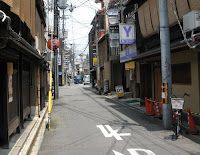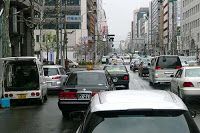What we learned in Kyoto
A couple of days riding in and around Kyoto reversed views on cycling I have formed over decades. Also, it showed me the part cycling might play in a more civil and liveable London.
Cycling works as well in Kyoto as it does in Copenhagen or Holland, but in different ways. (Not just that Japanese drive on the left as we do.) Londoners might usefully adopt some of its practices.

First, a disclaimer. What follows derives from a week’s observation in Osaka, Kobe and Kyoto, including two days cycling in Kyoto. I do not know national or city regulations governing cycling there, and report only what I observed of local practice.
Kyoto was laid out in a grid, copying a pattern pioneered in China. The major roads carry two-way traffic in two to six lanes and have footpaths that vary from 4-5’ wide to 20’. The back streets are less than two car widths across and carry one-way motor traffic. A few streets are covered over and serve as markets. They are barred to motor traffic. Otherwise all streets I saw were open to cars.
Bikes are parked everywhere. The streets are full of riders. Whether because of local laws and policies, or in spite of them, bikes are a big part of urban transport there.
The first thing a Londoner notices is that every footpath is shared use. Riders make their way through even quite dense foot traffic, patiently waiting for the way to clear, rarely walking, never ringing their bells. This is true even in quite crowded market streets. Pedestrians and riders peacefully share scarce space.
 The second difference to strike is that contraflow riding is ubiquitous on the narrow one-way streets. The back streets have no footpaths, and drivers share them with pedestrians and riders in both directions. The narrowness of the back streets effectively limits speeds to 20 mph, so none of this seems contentious.
The second difference to strike is that contraflow riding is ubiquitous on the narrow one-way streets. The back streets have no footpaths, and drivers share them with pedestrians and riders in both directions. The narrowness of the back streets effectively limits speeds to 20 mph, so none of this seems contentious.
On major roads few bicycles use the highway. Most use the footpath. At their widest Kyoto footpaths are divided into a bike lane, a narrow pedestrian-only lane, and between them, a shared-use lane. But these distinctions are generally ignored by pedestrians and cyclists alike. The narrowest footpaths carry no markings.
Most of the bikes we saw were humble. The city itself is quite flat, so three gears or none suffice. Small-wheel and folding bikes are very popular, but while we saw the occasional fine machine and visited the inspiring Vigore bike shop in the suburbs, there was no sign of the London urban single-speed biking style. As in England a generation ago, bicycles are utilitarian, with a sprinkling of enthusiasts.
We rented quite decent 24-speed mountain bikes and set out pottering through the back streets up to the Imperial Palace. This is a first-class way to explore the city. In London we usually ride fast. In Kyoto we were on holiday and stopped frequently to admire things and places that caught our attention. Traffic in the back streets moved slowly and we at no time felt concerned for our safety.
 When we had distance to cover we used the major roads. Traffic can be as heavy and fast as anywhere in London. In London we ride as ‘vehicular cyclists’, generally keeping up with the flow of traffic and managing opportunities for cars to pass us. This is not the practice in Kyoto, but it worked perfectly well and no motorist tried to crowd us.
When we had distance to cover we used the major roads. Traffic can be as heavy and fast as anywhere in London. In London we ride as ‘vehicular cyclists’, generally keeping up with the flow of traffic and managing opportunities for cars to pass us. This is not the practice in Kyoto, but it worked perfectly well and no motorist tried to crowd us.
The heaviest traffic we rode in was when coming home after a trip into the mountains. We felt too tired to mix with commuting cars on a crowded 6-lane highway. Happily we took to the footpath. At first, as we entered the city, the footpath was narrow, and we had to negotiate with pedestrians and other cyclists. In the centre of the city the footpath widened and lane markings appeared. We flew along.
 As a vehicular cyclist my safety depends on a culture of shared road use and respect for the law. Like other vehicular cyclists I fear the loss of road rights, actual or perceived, that might follow if cyclists are segregated from cars.
As a vehicular cyclist my safety depends on a culture of shared road use and respect for the law. Like other vehicular cyclists I fear the loss of road rights, actual or perceived, that might follow if cyclists are segregated from cars.
This is the case in one respect in Japan. Cyclists may not make right turns into 2-way streets. Instead they must cross an intersection on the left, and wait for the lights to change before setting off on the cross road.
Does that come with the package? If cyclists are allowed to use the footpath and ride contra-flow, must we then surrender road rights? Or could we retain them?
Following my London practice, I unwittingly put this to the test. In rain and heavy traffic, keeping up with the traffic flow, I made right turns from the rightmost of three lanes. No one seemed concerned. Japanese law might well restrict cyclists’ road rights, but the culture of shared road use does not require that. It seems to me we might allow cycling on footpaths without restricting road rights.
Any London cyclist will have spotted the flaw in this argument. Peaceful cycling on sometimes crowded Japanese footpaths requires a civility less often observed in London than Japan. But in London, footpath cycling is the preserve of scofflaws, is itself a gesture of defiance and contempt for others. Make it legal and commonplace, let the footpath fill with patient elderly cyclists. The scofflaws will find some other way to show off.
 We don’t in England have Japanese civility on the road or beside it. But that doesn’t mean we don’t want it. The popularity of the recent Tweed Runs – both among cyclists and pedestrians watching them – suggests a popular appetite for it. We might, cyclists and others, find common cause and be prepared to legislate for it. See my next post, “The new civilty”.
We don’t in England have Japanese civility on the road or beside it. But that doesn’t mean we don’t want it. The popularity of the recent Tweed Runs – both among cyclists and pedestrians watching them – suggests a popular appetite for it. We might, cyclists and others, find common cause and be prepared to legislate for it. See my next post, “The new civilty”.
